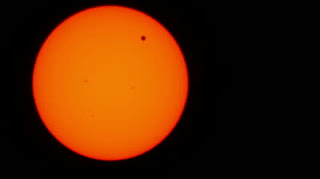Astronomy

- Planets Visited By Spacecraft
Planets Visited By Spacecraft Venus : Mariner 2 ( USA) flyby 1962 ...
- Sky Watching December 9-11
Sky Watching 2012,December 9-11 Sun., December 9, 3 a.m Vesta at opposition : ...
- Sky Watching Nov, 11-14
Sky Watching 2012 ,November 11-14 Jupiter is now in Taurus, close to Aldebaran and the Hyades. It rises about an hour after sunset, and...
- Planets
Mercury Diameter : 4,878km (3,032 miles) at its equator, which is about two-fifths of Earth's diameter. Orbit : 57,910,000 km (0.38 AU) from Sun. Orbiting the Sun once every 88 days. Average Distance : About 58 million...
- Picture Of The Day
Picture Of The Day October 18 , Thursday : ...
Astronomy
Planet Facts
Venus

Transit of Venus (Venus in black spot)
Venus is the second planet from the sun and the closest planet to Earth. It is named after The Roman Goddess of love and beauty, but it's extremely hot and deadly atmosphere makes it impossible for any human astronaut to explore it's surface. The diameter of Venus is about 7,520 miles which is about 400 miles smaller than that of Earth.
- Venus is known as Earths' twin sister because of its similar size and proximity to each other.
- Venus rotates so slowly that it orbits the sun faster than it can make one whole rotation on its axis. In other words, Venus has a longer day than year.
- And it takes 224 days for Venus to orbit around the sun.
- It takes 243 days for Venus to make a rotation.
- It is believed that Venus used to have bodies of water similar to Earth, but dried up over a period of 300 million years when the sun began admitting more solar energy after the sun's infancy stage.
- The clouds of Venus is filled with sulfuric acid.
- Venus has mountains that are higher than Earth. Maat Mons is more than 5 miles high.
- Venus is the brightest planet viewed from Earth.
- Its atmosphere is made up mostly of carbon dioxide.
- Venus is the most widely explored planet aside from our own Earth. Numerous space probes have been sent to Venus to gather data and some have landed on the surface. The first spacecraft to visit Venus was Mariner 2 in 1962. It was subsequently visited by many others , including Pioneer Venus and the Soviet Venera 7 the first spacecraft to land on another planet, and Venera 9 which returned the first photographs of the surface. Most recently, the orbiting US spacecraft Magellan produced detailed maps of Venus' surface using radar.
- Planets Visited By Spacecraft
Planets Visited By Spacecraft Venus : Mariner 2 ( USA) flyby 1962 ...
- Sky Watching December 9-11
Sky Watching 2012,December 9-11 Sun., December 9, 3 a.m Vesta at opposition : ...
- Sky Watching Nov, 11-14
Sky Watching 2012 ,November 11-14 Jupiter is now in Taurus, close to Aldebaran and the Hyades. It rises about an hour after sunset, and...
- Planets
Mercury Diameter : 4,878km (3,032 miles) at its equator, which is about two-fifths of Earth's diameter. Orbit : 57,910,000 km (0.38 AU) from Sun. Orbiting the Sun once every 88 days. Average Distance : About 58 million...
- Picture Of The Day
Picture Of The Day October 18 , Thursday : ...
